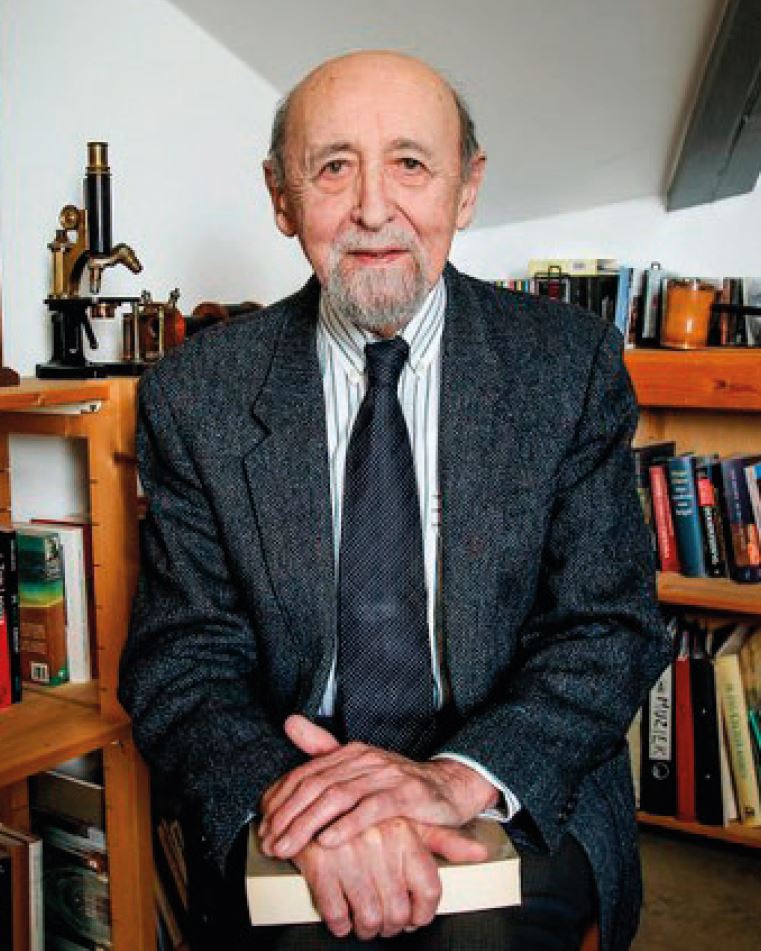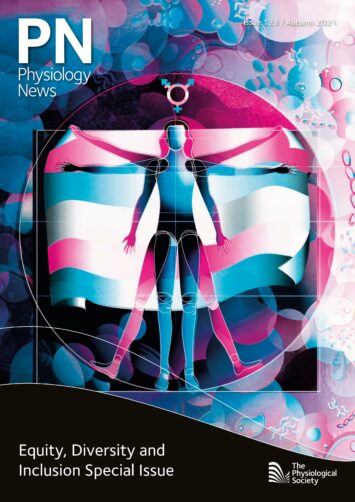
Physiology News Magazine
Obituary: Professor Edward Carmeliet 1930 – 2021
Membership
Obituary: Professor Edward Carmeliet 1930 – 2021
Membership
https://doi.org/10.36866/pn.123.46

Professor Edward Carmeliet died on 5 April 2021 at the age of 91, just after retiring from a research career spanning the early 1950s to 2020. He was a pioneer in cardiac electrophysiology and throughout his life pursued deeper understanding of mechanisms underlying the action potential and the implications for arrhythmias, leaving a rich legacy.
His research started in the exciting years of the first recordings of action potentials from the heart. Early during his medical studies in Leuven, his physiology teacher, the late Professor Bouckaert, invited Professor Carmeliet to join the lab as a student- researcher. At that time, neurophysiology and skeletal muscle were the main topics, and Professor Carmeliet started on cardiac muscle, initially using the frog heart and subsequently mammalian Purkinje fibres. In 1952, he published his first paper on the effects of temperature and in 1955 published, as sole author, on a topic that stayed with him for the rest of his career, the modulation of the cardiac action potential by frequency. Indeed, in 2006, he wrote a review that incorporated 50 years of experimental evidence and scientific insight in the complexity of frequency-dependent modulation of the action potential duration by altered channel gating and slow changes in ion composition (Carmeliet, 2006).
With a focus on the regulation of the action potential, he studied many ionic currents and ion transporters, and a first interest was Cl-. Professor Carmeliet joined the group of Silvio Weidman in Bern, Switzerland, studying Cl- and K+ conductances (1958 – 1961). His work on Cl- was the first ever to show increased contribution of Cl- at depolarised potentials in Purkinje fibres. Back in Leuven, he used radioactive tracers for ion flux measurements with his early collaborators, Fons Verdonck and Suzanne Bosteels.
By the late 1960s, voltage clamp in cardiac multicellular preparations began. With Johan Vereecke, who became his life-long collaborator, he visited Johnson and Lieberman at Duke University (1972). With Gerrit Isenberg, he worked at combining voltage clamp and isotope flux studies in Purkinje fibres. He then moved on to use single cardiac myocytes, first using two microelectrodes, and from the early 1980s, patch clamp methods, complemented with molecular biology studies. Jean Prenen was for many years his trusted technician skilled in cellular electrophysiology, with Luce Heremans providing the “wet-lab” support.
An example of his life-long interest in methodological innovation is his work on the late Na+ current. Early work using Purkinje fibres (Carmeliet & Saikawa, 1982) eventually led to transgenic mouse studies with his son, Peter Carmeliet, on LQT3 (Nuyens et al., 2001). Interest in Na+ homeostasis, further explored by Fons Verdonck, and work on ATP-sensitive K+ channels were linked to a broader interest in ischaemia and cardioprotection. In 1990, an international symposium at the occasion of his 60th birthday addressed the wide involvement of ion channels and transport in ischaemia, including contributions on metabolism, pH regulation, oxidative stress, cell death and Na+ and Ca2+ homeostasis. The work eventually led to his authoritative review published in 1999 (Carmeliet, 1999).

A major topic of study were K+ currents. The proceedings of a symposium in 1995 on cardiac K+ channels honour his many contributions to the field, and position his work in the global scientific network. Out of his many papers, we cite the work on blockers of the “delayed rectifier” K+ current, the properties of the background (IK1) and of the ACh-sensitive K+ channel, with Kani Mubagwa and Achilles “Oggie” Pappano, as well as the study of the Na-activated K+ channels. Calcium homeostasis was part of his comprehensive view, converging with his early interests in Cl- in study of Ca-activated Cl- currents, with Karin Sipido and Zoltan Papp. His deep knowledge of ion channels and their modulation were at the basis of his membership in the international study group on anti-arrhythmics, the Sicilian Gambit.
Professor Carmeliet was very interested in the elucidation of pacemaker mechanisms. These were first thought to be linked to a waning K+ conductance, but the work eventually led to the discovery of the funny current, and later expanded into the comprehensive view of a complex clock mechanism, aptly reviewed in 2019 in Physiological Reports (Carmeliet, 2019).
Professor Carmeliet served on the board of many distinguished journals. He was an active member of The Physiological Society, attending meetings and introducing his students to The Society. He was a member of the Editorial Board of The Journal of Physiology from 1980 to 1987 and remained an active reviewer throughout his life. With Edouard Coraboeuf and Silvio Weidman, he founded, in 1977, the European Working Group on Cardiac Cellular Electrophysiology, a meeting place for discussion of ongoing work, for scientific and social exchange and especially for including young researchers in the scientific network.
With more than 200 collaborators and former students, the publications of Professor Carmeliet cover the world map and bear testimony to his influence in the field. He reached out to scientists who were working in more difficult conditions, e.g. in the ‘60s and ‘70s in Eastern Europe, in China and Taiwan. Collaborations often entailed longer- term visits to the lab in Leuven, to the joy of the local team who could then work with prominent scientists.
Professor Carmeliet was a cautious and rigorous scientist, as critical of his own work as of that of others, but always in a collegial and friendly manner. We, his students, were taught the same. A famous expression was “één is geen”, i.e. one observation means nothing. We were encouraged to write that data “suggest” or “indicate” as a definite proof is always difficult to establish. Discussing results and experiments in an open and constructive manner, he shared his enthusiasm and scientific passion with many.
Professor Carmeliet was married to Joanna “Jeanne” Amerijckx from 1955 until her death in 2015. She gave a homely welcome to all visitors and students, and accompanied Edward on many travels. They had four children, Bart, Geert, Peter and Jan. Geert investigates bone metabolism and development, and Peter studies angiogenesis and its role in cancer. Peter gave The Physiological Society’s Michael de Burgh Daly Prize Lecture in 2013.
Following the news of Professor Carmeliet’s death, numerous messages from colleagues around the world testified how his warm personality and extraordinary scientific spirit left their mark. He is deeply missed.
Written by Karin R. Sipido, Department of Cardiovascular Sciences, KU Leuven, Belgium, Kanigula Mubagwa, Catholic University of Bukavu, DR Congo, Fons Verdonck, Faculty of Medicine, KU Leuven, Belgium and Johan Vereecke, Faculty of Medicine, KU Leuven, Belgium.
The authors thank David Eisner, Manchester University, for his help in preparing the manuscript and Rob Stevens, KU Leuven for providing the photograph.
References
Carmeliet E (1999). Cardiac ionic currents and acute ischemia: from channels to arrhythmias. Physiological Reviews 79(3), 917–1017. https://doi.org/10.1152/physrev.1999.79.3.917
Carmeliet E (2006). Action potential duration, rate of stimulation, and intracellular sodium. Journal of Cardiovascular Electrophysiology 17 Suppl 1, S2–S7. https://doi.org/10.1111/j.1540-8167.2006.00378.x
Carmeliet E (2019). Pacemaking in cardiac tissue. From IK2 to a coupled-clock system. Physiol Rep 7(1), e13862. https://doi.org/10.14814/phy2.13862
Carmeliet E and Saikawa T (1982). Shortening of the action potential and reduction of pacemaker activity by lidocaine, quinidine, and procainamide in sheep cardiac purkinje fibers. An effect on Na or K currents? Circulation Research 50(2), 257–272. https://doi.org/10.1161/01.res.50.2.257
Nuyens D et al. (2001). Abrupt rate accelerations or premature beats cause life-threatening arrhythmias in mice with long-QT3 syndrome. Nature Medicine 7(9), 1021–1027. https://doi.org/10.1038/nm0901-1021
